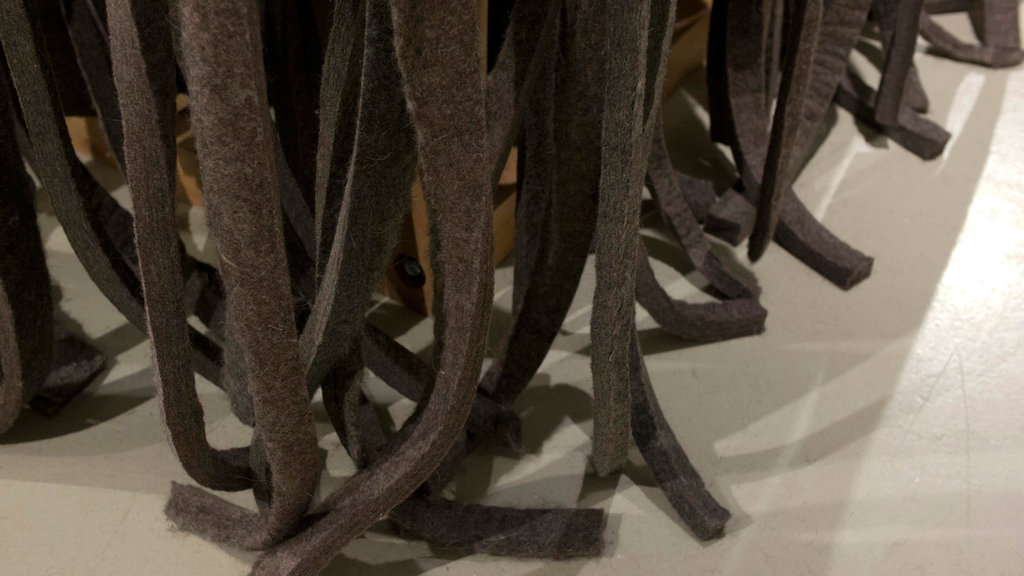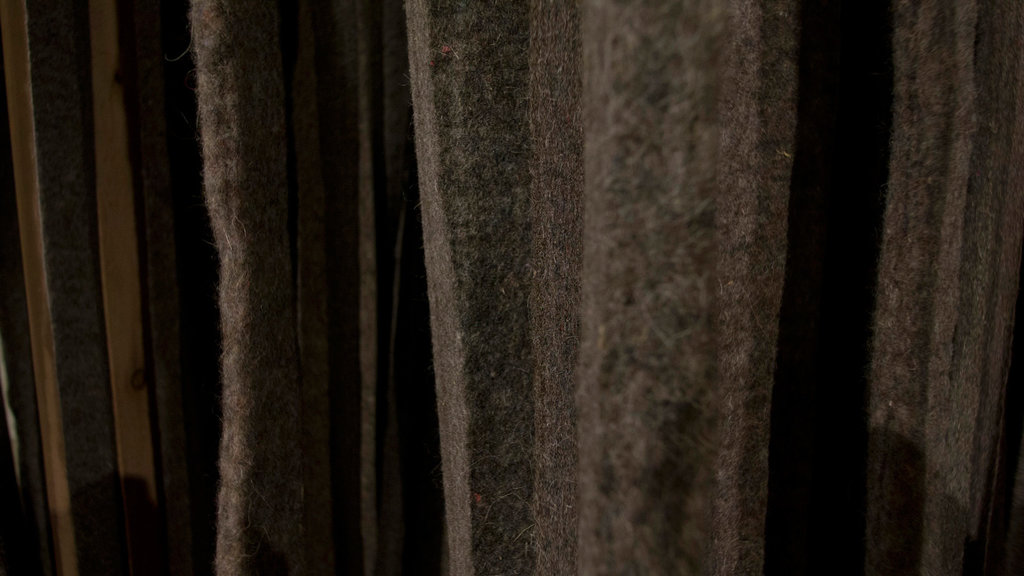Ellen Bleiwas’ exhibition Passage No. 170424 in Angell Gallery’s project space defies the clichés historically associated with “fibre art”. It is true that the work serves as a “softer” counterpart to Greg Haberny’s Rise Then Shine in the main gallery space, which also explores the psychological impact of materials and spaces. However, nothing about Bleiwas’ treatment of her material particularly suggests femininity, domesticity or craft. The installation, entitled Passage No. 170424, consists of thick strips of dark grey industrial wool felt hung in layers from a cube-shaped cedar frame, appears massive, heavy and austere. When viewed from the hallway outside the project space, it seems as if the room can barely contain it.
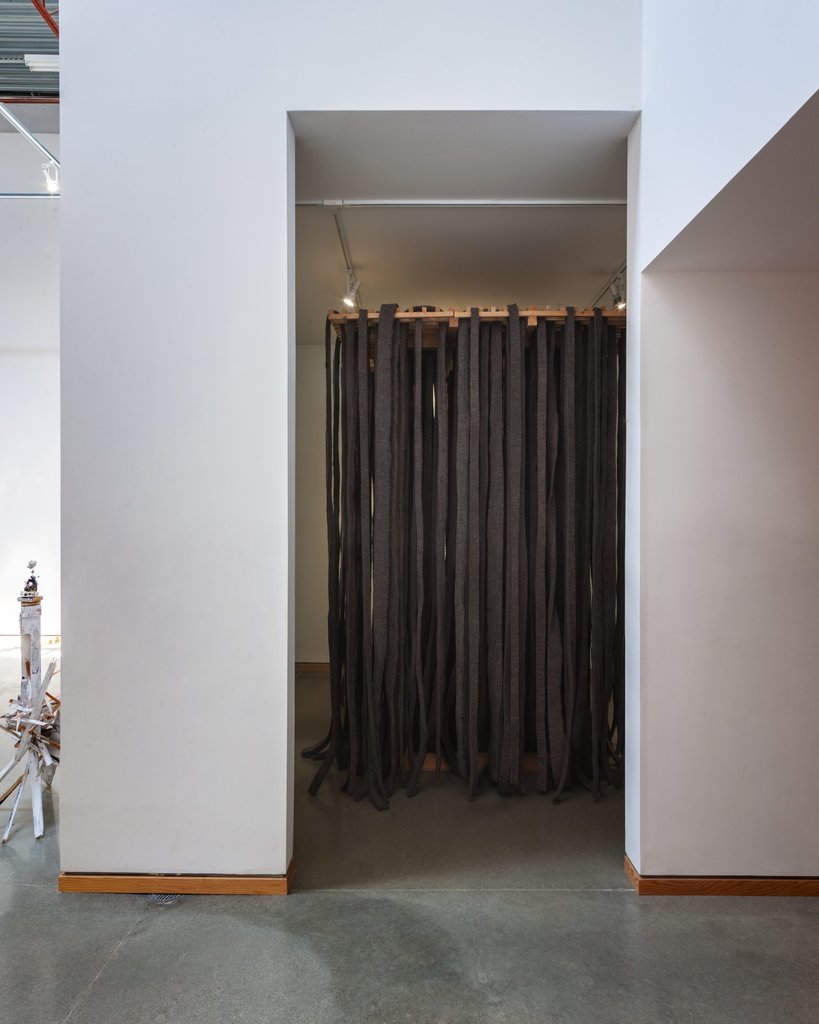 Installation view of Ellen Bleiwas, Passage No.170424 at Angell Gallery. Photo: Alex Fischer
Installation view of Ellen Bleiwas, Passage No.170424 at Angell Gallery. Photo: Alex Fischer
As you move closer, the formalist elements fall away as the more organic qualities of the material become evident: the strips of felt are not perfectly uniform in size, shape or in the way they hang. They shed fibres and give off a vaguely animal smell. The work invites visitors to feel the material, which is pliable and slightly itchy, and move through the layers to reach the open space in the center, just big enough for one person to stand. Once inside the work, the woolly smell is heightened, but the sounds from outside are dampened significantly. Vision is impaired beyond the light streaming in from above and the obscure forms of bodies moving around the work, which can be seen through the cracks between the felt. The curtains become slightly agitated from other visitors brushing past and touching them.
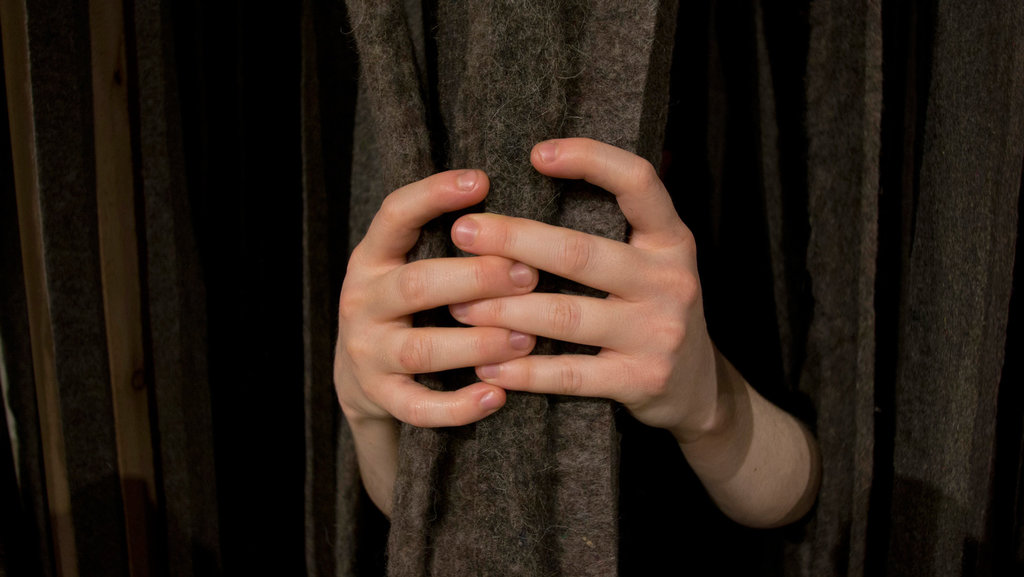 Ellen Bleiwas, Passage No.170424 at Angell Gallery. Photo: Eva Kolcze
Ellen Bleiwas, Passage No.170424 at Angell Gallery. Photo: Eva Kolcze
What makes Passage No. 170424 so compelling is these dual experiences; one as a viewer and one as a participant. Involving the onlookers from the outside, the strength of its material, its form and the possible occupation of its space can engage multiple viewers collectively. Once inside, the seclusion and sensorial manipulation at play subtly encourages self-awareness and reflection in a way that is completely unique for each participant. If given the opportunity to go inside and come back out of the work multiple times, visitors may find that their external experience informs their internal one and vise-versa. What initially evoked comfort, anxiety or reticence, has developed into an entirely different sensation by their second or third time entering.
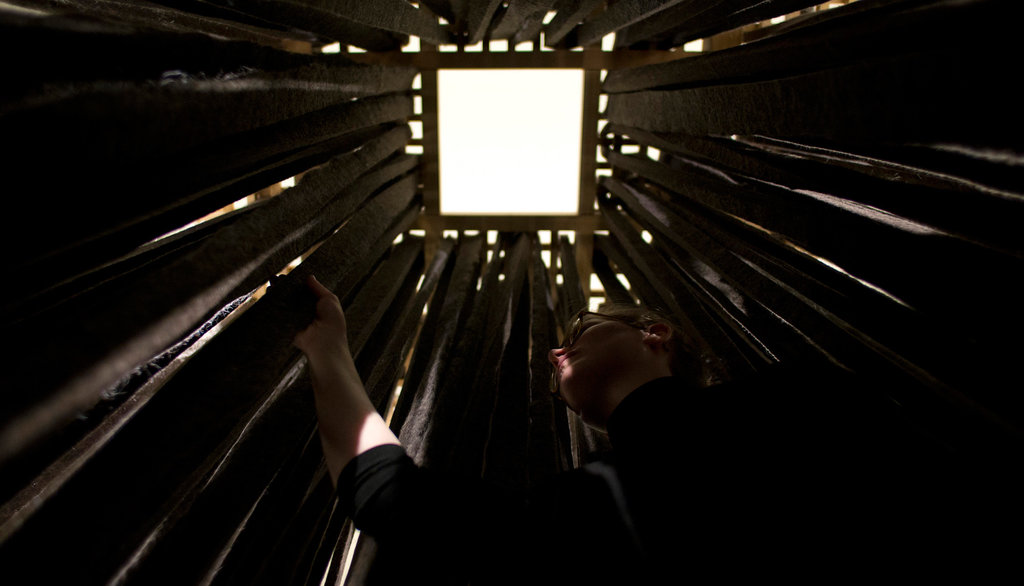 Installation view of Ellen Bleiwas, Passage No.170424 at Angell Gallery. Photo: Eva Kolcze
Installation view of Ellen Bleiwas, Passage No.170424 at Angell Gallery. Photo: Eva Kolcze
Accompanying the exhibition’s eponymous installation are several smaller works, including some worn by the gallery staff, offering a localized sensory experience where the installation offers an immersive one. Spirals of felt, dipped in beeswax to hold their shape, are worn as cuffs on the wrists and ears. This provides a peculiar haptic sensation that is both comfortable and slightly abrasive against these sensitive areas of skin. Olfactory and auditory sensations are also present, due to the beeswax and the noise dampening quality of the felt. The cylindrical felt head piece functions similarly, but with the added limitation of vision. Relational work has a tendency to induce feelings of self-consciousness in participants, but among all the works in Bleiwas’ exhibition, the head piece is the one that has the best chance of evoking a strong feeling of vulnerability in its wearers.
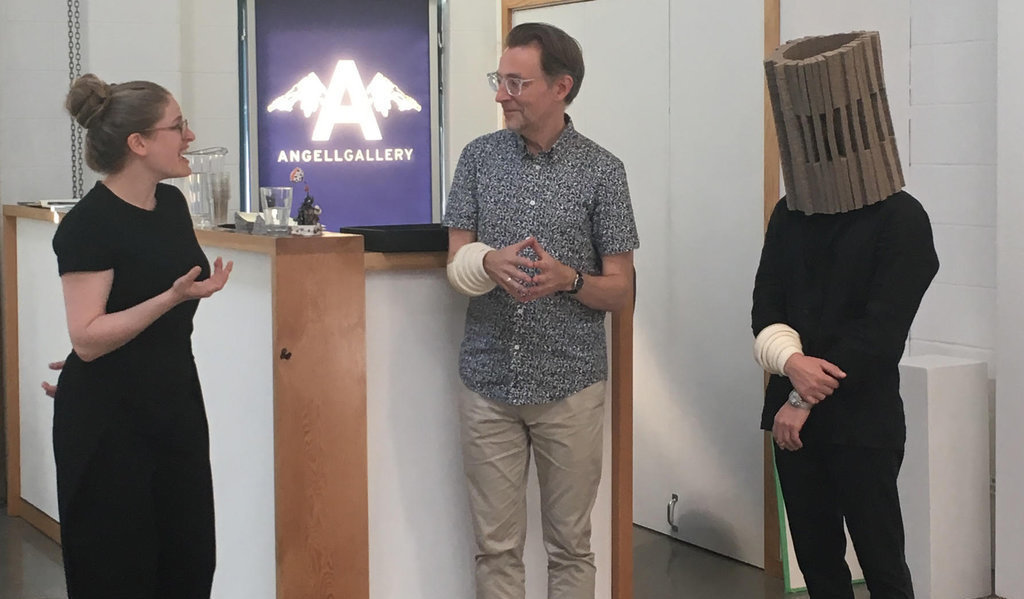 Artist, Ellen Bleiwas (left), Bill Clarke, Associate Director (centre) wearing wrist cuffs and Noah Gano, Gallery Associate (right) wearing the head piece at the Artist Talk, September 23, 2017. Photo: Eva Kolcze
Artist, Ellen Bleiwas (left), Bill Clarke, Associate Director (centre) wearing wrist cuffs and Noah Gano, Gallery Associate (right) wearing the head piece at the Artist Talk, September 23, 2017. Photo: Eva Kolcze
In the backroom of the gallery, visitors will find a series of works that provide some context for Bleiwas’ practice. Passage No. 140102 and Spiral No. 141129 are the two oldest works in the show and could be viewed as maquettes for larger installations such as the one in Angell’s project space. Drawing on her background in architecture, Bleiwas has long been interested in creating spaces that are psychologically powerful, rather than utilitarian. Even on their small scale, you can anticipate how moving through these imaginary passages might affect you. The more recent work Spiral no. 170826, evidently produced in the same method as the wrist cuffs, takes a step back from the idea of space to focus on another architectural element that is evident across all Bleiwas’ work: the integrity of materials, process and form. The winding, dipping and pulling of the felt is a delicate manipulation that allows the material to still be very much what it is. The work still draws viewers inside though, as spirals tend to do, through a hole at the top of its conical form. As you lower your eye to the hole, you are met by a mirror reflection of it. The confrontation with yourself has the same type of infinite potential emotional responses as the main installation.
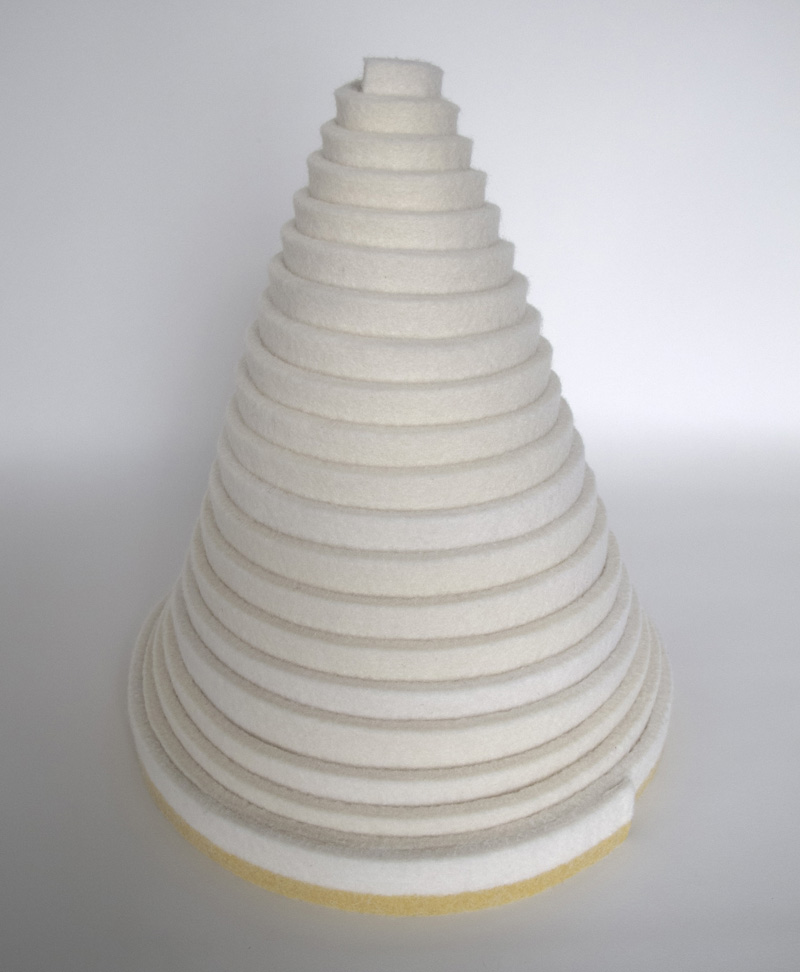 Ellen Bleiwas, Spiral No 170826. Courtesy of the artist
Ellen Bleiwas, Spiral No 170826. Courtesy of the artist
Moving away from spaces for human occupation entirely, the work Sphere No. 170406, a ball of felt strips wrapped around themselves, allows the material to take up mass and just be an object in and of itself. The artist’s latest series of works, Protrusions, is a continuation of this idea, consisting of solid, carved hunks of felt dipped in beeswax that resemble mini monoliths. This comparison resonates and connects many of the ideas throughout Bleiwas’ body of work. Both naturally occurring and man-made monoliths have an awe-inspiring quality and felt, like stone, has a utilitarian aesthetic based on the way it was produced, which cannot be removed even when carved or built with. In this way, the material, sensorial and psychological elements present throughout Passage No. 170424 are beautifully and intelligently consolidated.
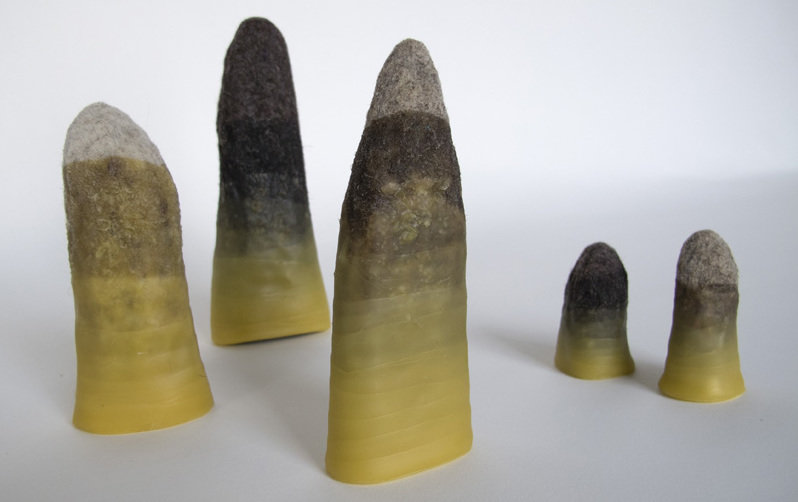 Ellen Bleiwas, Protrusions No 170825. Courtesy of the artist
Ellen Bleiwas, Protrusions No 170825. Courtesy of the artist
Emily Austin
*Exhibition information: September 8 – October 7, 2017, Angell Gallery, 1444 Dupont St., Unit 15, Toronto. Gallery hours: Wednesday – Saturday, 12 – 5 pm.
**Note: Industrial felt sourced from The Felt Store.

